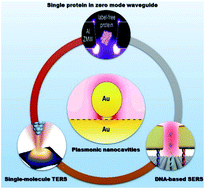Recent advances in plasmonic nanocavities for single-molecule spectroscopy
Abstract
Plasmonic nanocavities are able to engineer and confine electromagnetic fields to subwavelength volumes. In the past decade, they have enabled a large set of applications, in particular for sensing, optical trapping, and the investigation of physical and chemical phenomena at a few or single-molecule levels. This extreme sensitivity is possible thanks to the highly confined local field intensity enhancement, which depends on the geometry of plasmonic nanocavities. Indeed, suitably designed structures providing engineered local optical fields lead to enhanced optical sensing based on different phenomena such as surface enhanced Raman scattering, fluorescence, and Förster resonance energy transfer. In this mini-review, we illustrate the most recent results on plasmonic nanocavities, with specific emphasis on the detection of single molecules.

- This article is part of the themed collections: Popular Advances and Recent Review Articles


 Please wait while we load your content...
Please wait while we load your content...